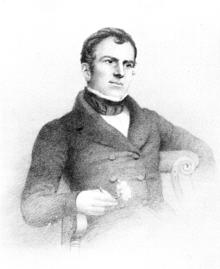William Griffith (botanist)

William Griffith (1810 – 9 February 1845[1]) was a British doctor, naturalist, and botanist. Griffith's botanical publications are from India and Burma. After a brief stay in Madras, he was assigned as a Civil Surgeon to Tenasserim, Burma, where he studied local plants and made collecting trips to the Barak River valley in Assam. He explored various parts of Burma, traveling the rivers, including the Irrawadi as far as Rangoon. He visited the highlands of Sikkim, and the region of the Himalayas around Shimla. Subsequently, Griffith was appointed as Civil Surgeon in Malacca, where he died of a parasitic liver disease.
Biography

William was born at Ham in March 1810. He studied under a private tutor along with brothers and even in his early days, took an interest in botany. He later went to London University where he studied under Robert Brown and Lindley. He received the Linnaean Gold Medal of the Society of Apothecaries in 1830 (botanical class) and joined the East India Company as an assistant surgeon at Madras on 24 September 1832. In 1835 he was deputed to join Nathaniel Wallich and John McClelland on a mission to examine tea cultivation in northeastern India. The Commissioner in Assam, Jenkins, later deputed him to visit the Mishmi Hills and the Lohit valley. He served with Major Robert Boileau Pemberton's mission to Bhutan in 1837. In 1839 he visited the Indus region and studied the botany of Afghanistan, returning to 1841 and recuperating in Shimla before visiting his brother at Jabalpur. When Nathaniel Wallich visited South Africa, he was made in-charge of the Calcutta Botanical Garden and also acted as Professor of Botany at the Medical College from 1842 to 1844. On being relieved, he moved back to the Straits of Malacca, falling ill and dying of a liver disorder on 10 February 1845. The Calcutta Journal of Natural History, produced with assistance from him ceased and the subscriptions were used by John McClelland to publish Griffith's unpublished manuscripts.[2]
A memorial tablet was placed at the St. George's Cathedral in Madras.[2]
Taxa named in honour
There are number of plants with specific names griffithianus, griffithia and griffithii named in honour of William Griffith. Including; Bulbophyllum griffithii, Euphorbia griffithii, Iris griffithii, Magnolia griffithii and Larix griffithii.[4][5]
Selected publications
- Griffith, William (1847) Journals of Travels in Assam Burma Bootan Affghanistan and the Neighbouring Countries Bishop's College Press, Calcutta; reprinted 2001 Munshiram Manoharlal Publishers, New Delhi.
Notes
- ^ "Obituary". Annals and Magazine of Natural History. 15: 447. 1845. doi:10.1080/037454809495373. Retrieved 19 January 2016.
- ^ a b Anon. (1847). "Biographical memoir of the late William Griffith". Madras Journal of Literature and Science. 14: 187–197.
- ^ International Plant Names Index. Griff.
- ^ Stearn, William (1973). A Gardener's Dictionary of Plant Names (Revised ed.). London: Cassell (published 1963). p. 159. ISBN 0304937215.
- ^ D. Gledhill The Names of Plants, p. 184, at Google Books
References
- Lang, W. H. (1913) "William Griffith, 1810-1845" in Oliver, Francis W. (ed.) (1913) Makers of British Botany: A Collection of Biographies by Living Botanists Cambridge University Press, Cambridge, UK, pp. 178-191, OCLC 5146484
- Arnold, David (2006) The Tropics and the Traveling Gaze: India, Landscape, and Science, 1800-1856 University of Washington Press, Seattle, pp. 16–17, 63, 65, 67, 144, 157, 159, 167, and 171–176, ISBN 0-295-98581-X
External links
- Works by William Griffith at Project Gutenberg
- Works by or about William Griffith at the Internet Archive
- Works by William Griffith (1810-1845) at Biodiversity Heritage Library
- "William Griffith British Botanist" The Beauty of Orchids and Flowers website
